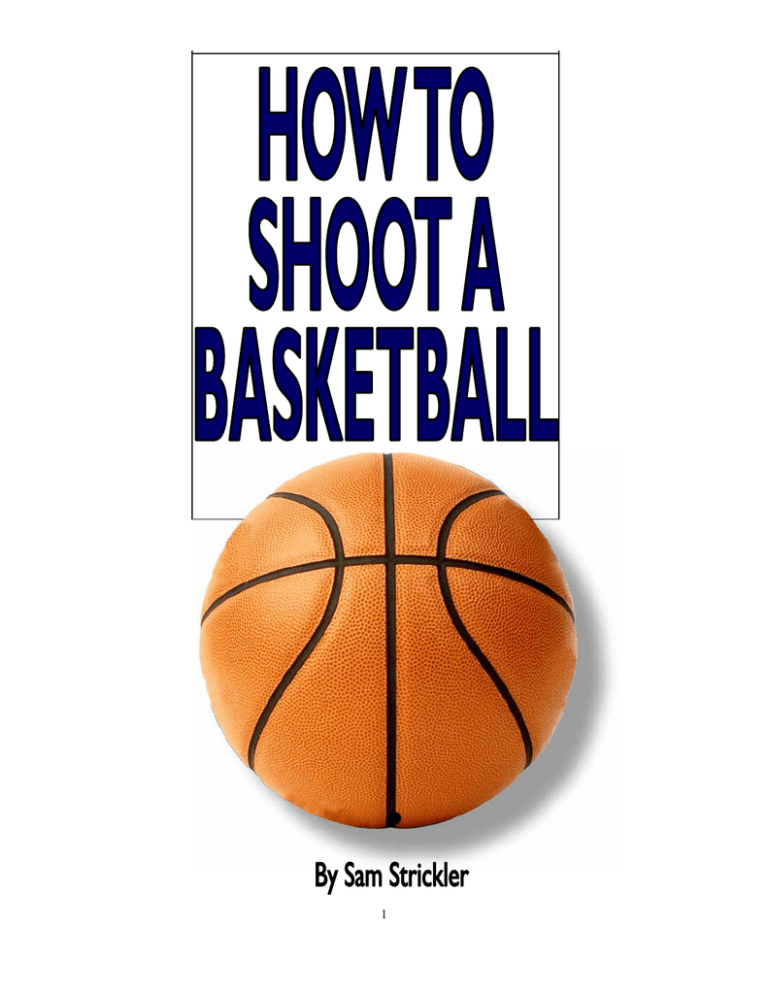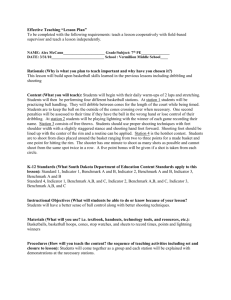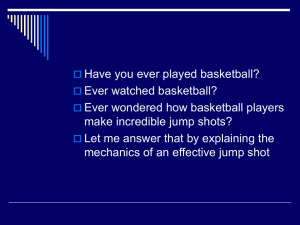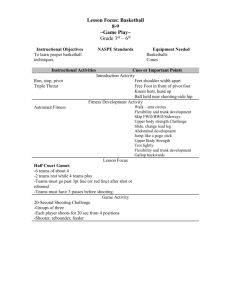1
advertisement

1 HOW TO SHOOT A BASKETBALL INTRODUCTION & MATERIALS LIST INTRODUCTION Basketball is an exciting sport. It is fun to play and watch. If you are a player, it can be even more exciting if you know how to shoot well. That is the purpose of this document: To teach the correct form and fundamentals about the art of shooting a basketball. The audience for these instructions range from new players who want to learn how to shoot to advanced players who want to improve their shooting skills. No matter what your current skill level, you will gain valuable insight, tips and techniques on shooting from this article. NOTE: These instructions are based on right handed shooters. Simply reverse the instructions for lefthanded shooters MATERIALS NEEDED • Basketball (see basketball specifications in illustration at right) *** • Gym shorts and shirt • Gym shoes (See warning below) *** Required for instructions WARNING Ankle injury possible if playing basketball without footwear with ankle support. 2 HOW TO SHOOT A BASKETBALL FOOTWORK, BALANCE & GRIP FOOTWORK AND BALANCE Balance and footwork are the foundation of good shooting form and must be learned prior to taking a shot. Both are important because bad footwork can cause bad balance, which usually leads to poor shooting form and low shooting percentage. Footwork and balance are also important because the rhythm of the shot starts with the feet, moves up through the torso and through the shooting arm, hand and fingers. Refer to Figure 1 below to seen an example of correct footwork. POCKET 2 TRIPLE THREAT POSITION. Slightly bend your knees, elbows, wrists, and ankles in what is called the triple threat position. Ball should be in the “pocket” in front of torso. 1 FOOTWORK. Firmly plant feet shoulder width apart with the right foot slightly ahead of the left foot. Square the shoulders up with the basket. GRIP The basketball should be held firm enough to have control without it slipping from grip. The fingers are used instead of the palm of the hand to give more control and to help guide the ball later on in the process. Use Figure 3 as a visual guide as how to grip the basketball while shooting. NON In order to achieve good balance a shooter SHOOTING HAND needs to be in the triple threat position whenever the individual has the possession of the ball. The triple threat position provides the user the optimal SHOOTING position to pass, dribble or shoot and is shown in HAND Figure 2 at the top right of the page. Although this article focuses on shooting, the triple threat posiGRIP. Hold the ball gingerly so the tion is the foundation of basketball’s three fundathumb of the shooting hand touches mental moves; dribble, pass and shoot. 3 the palm of the guide hand. This should create a “T” between your right thumb and left palm 3 HOW TO SHOOT A BASKETBALL SHOOTING LANES & FOCUS SHOOTING LANES After learning the foundation, a shooter must know where to face when shooting. Shooting lanes consist of the alignment of the body when facing the rim. Direct the feet towards the rim for optimal shooting results. Look at Figure 5 below to see the difference between good and bad shooting lanes. Bad shooting lanes increase the degree of difficulty and decrease shooting accuracy. FOCUS Vision is the next aspect of shooting and is probably the most overlooked. A shooter needs a location to consistently aim the basketball when shooting. Most beginners think aiming at the basket is all that is needed when shooting, but this is wrong. 5 FOCUS. Your eyes should be focused on the back of the rim throughout the shooting process. There are three targets which are taught by coaches for aiming and shooting a basketball. The front of the rim, the middle of the rim and the back of the rim. The shooter must decide first which target he feels the most comfortable shooting at, consistency is the key. The first two are good but the third is the best because of its simple geometry. If a shooter undershoots the basketball there is a good chance the ball will still go in, where the other focus locations come up short. 4 SHOOTING LANES. Body should be aligned towards the basket. (1) shows a good shooting lane and (2) shows a bad shooting lane. 4 HOW TO SHOOT A BASKETBALL ELBOW & RELEASE ELBOW Alignment is essential to good form in shooting and the elbow is what causes problems. The elbow should be directly in line with the shoulders throughout the shot and should rise underneath your shooting hand. As the ball is raised, the legs should be used as the power for the shot. Somewhere between the shoulders and the fully extended shooting arm, the non shooting hand should be removed from the ball. This leaves the shooting hand free to direct the flight of the ball. The non shooting hand is only used to raise a ball to a point and is known as the “guide hand.” 7 FOLLOW THROUGH. The middle finger should be last to touch the ball as it is released. The wrist should flick down in the form of a swan’s neck if the follow through is correct. 90 degrees 6 ELBOW. As the arms raise the ball, the elbow should be aligned under the ball and should create a 90 degree angle. FOLLOW THROUGH The follow through helps direct the ball in the right direction and creates backspin on the ball. This is important because backspin softens the shot and makes the ball spin backwards when contacting the rim. This is known as “touch” and helps the ball bounce around on the rim. See figure 7, above, as a an example of good follow through. Also refer to the lying follow through drill near the end of the document as a follow through practice tool. TIP: 5 The follow through is what creates the great rotation of the basketball. Try practicing without a goal and, if the ball has correct backspin, it should come back to you when it hits the ground. HOW TO SHOOT A BASKETBALL ARC & RANGE ket from which he can consistently make shots without sacrificing form. A beginner should start by shooting shots close the basket and, once the form is perfected, move further from the basket. ARC The arc of a shot should depend upon the range at which you are shooting. The larger the approach angle of a shot, the greater the diameter of the rim. The angles of arc and their corresponding geometries can be seen in the illustration below. Therefore as the arc of the shot increases, so do the chances of the ball going in. Basketball Quote “Good, better, best. Never let RANGE To increase shooting percentage—the number of successful shots divided by the total number of shots taken— a shooter should shoot only within his range. A shooter’s range is the distance from the bas ARC. The more arc a shot has, the better chance it has at going in. A high arc also helps shoot above athletic defenders. (Illustration courtesy of http:// www.advantage basketball.com/ shootin) it rest. Until your good is better and your better is best.” - Tim Duncan (1) The arc angle of the ball as it approaches the rim and its corresponding rim diameter. 6 (2) The trajectory of a ball on its path towards the basket at different angles. HOW TO SHOOT A BASKETBALL CONSISTENCY, CONCLUSION & FOLLOW THROUGH DRILL The Lying Follow Through Drill CONSISTENCY If a player shoots 10,000 shots and is not consistent with how he shoots them, the time has been wasted. A consistent form needs to be used with every shot for the motion to become permanent in a player’s muscle memory. 1. Lie on your back and place the ball at your right shoulder in triple threat position. Your palm should be facing up towards the ceiling or sky. CONCLUSION This document has provided the tools to build a fundamentally correct and accurate shot, but perfection won’t occur in one day. The more you practice the form of shooting, the more natural it will become. After good form becomes natural, an increase in shooting accuracy is sure to be seen. Whether you’re an advanced basketball player or a beginner, these instructions will help you improve your game. TIP: Figure 1. First step of Lying Follow Through Drill (photo courtesy of http://www.shootingdrills.com/ floordrill.html). 2. Shoot ball straight up in the air while putting back spin on it. Hold the follow through position as your palm should be down towards the ground. 3. Catch ball and repeat Try to practice shooting in game speed and under game like fatigue to get desired game results. For additional information on basketball visit: • www.nba.com • www.ncaasports.com If you would like information on basketball equipment please visit: • www.eastbay.com Figure 2. Step 2 of drill. (photo courtesy of http:// www.shootingdrills.com/floordrill.html). Drill Practice Length: 25 Repetitions 7 HOW TO SHOOT A BASKETBALL TROUBLESHOOTING PROBLEM #4: Short shot The ball consistently comes up short SOLUTION: a. Shooting from beyond a player's range. b. Falling backward while taking the shot. This is common balance problem as the weight is over the heels rather than the balls of the feet. This section provides a list of problems that may be prevalent among shooters. The provided solutions need to used in reference with the prior article of fundamentals. PROBLEM #1: Oblong ball rotation This is where the ball will have an oblong or sideways rotation to it. SOLUTION: a. Incorrect feet placement and an incorrect center of gravity. b. The guide hand was improperly placed, interfering with the shot on the release. PROBLEM #5: Long shot The ball consistently goes long SOLUTION: a. “Pushing the ball.” b. Shooting from beyond a player's range. Basketball Quote PROBLEM #2: Flat rotation or no rotation: This is where the ball has little or no rotation. SOLUTION: a. Poor or no follow through. The shooter did not snap their wrist at the apex of the shot. b. "Pushing the ball”. This is very common and happens when the shooter pushes the ball in the direction of the basket instead creating a 90 degree angle with the shooting arm. This is very common and is very prevalent among novice basketball players. “The only difference between a good shot and a bad shot is if it goes in or not.” - Charles Barkley PROBLEM #3: Flat shot The shot takes a low-angle path to the basket, rather than a high arc which provides a larger target. SOLUTION: This is caused by “pushing the ball” which is defined above. “Pushing the ball is often the result of the shooter being outside their shooting range. PROBLEM #4: Consistent miss to left or right Ball consistently misses to the right or to the left of the basket: SOLUTION: a. Shoulders are not square to the basket. b. Feet are planted too close together when taking a moving shot resulting in unstable balance. c. Elbow out instead of aligned with shoulder. d. The shooting hand is improperly placed on the ball. e. Feet are not pointing at the basket. 8



